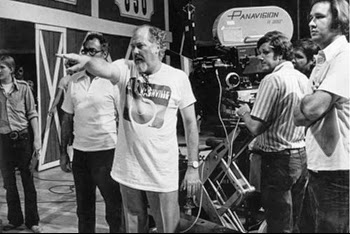By Scott Ross
Even granting Robert Altman’s stylistic exercises of the early 1970s, for those who saw it on its release Nashville must have had the galvanic force of revelation. It’s unlike any movie made before it and, while many have tried to ape it, like no movie since. It’s a big, satirical lark in the form of an American epic, a character study of two-dozen people in and around the center of the country music industry that somehow stints none of them. While some of the actors (particularly Henry Gibson, Ronee Blakely and Lily Tomlin) have more screen time than others, the effect is less mosaic than mass portraiture.
Joan Tewkesbury wrote the splendidly elliptical screenplay, embellished as usual by the improvisations of Altman and his cast, and everything in it works. Everything. There are so many great moments it’s almost a compendium of the things Altman could do better than anyone else. The music, which has an absolute authenticity, is largely the work of the cast: Blakely, Gibson, Karen Black, Keith Carradine, Allan Nicholls and Dave Peel wrote their own songs, with assists from Joe Raposo and Gary Busey and a number of Nashville stalwarts like Vassar Clements, many of whom have screen time. (Carradine even got a radio hit, and an Oscar, for his, the ironically titled “I’m Easy.”) The cast list is extraordinary and includes David Arkin, Barbara Baxley, Ned Beatty, Timothy Brown, Robert DoQui, Shelley Duvall, Allen Garfield, Scott Glenn, Jeff Goldblum, David Hayward, Michael Murphy, Cristina Raines, Bert Remsen, Gwen Welles, and Keenan Wynn (Elliott Gould and Julie Christie also show up, playing themselves; they were in Nashville to visit Altman and got talked into joining the cast — as did George Segal, whose scenes, alas, ended up cut from the picture.)

Tomlin does what may be her finest movie work here, as does Barbara Harris as a woman who memorably (and un-ironically) says she’s “going to Nashville to become a country singer, or star”; Geraldine Chaplin is extremely funny as a pretentious, phony “reporter” who is too busy ruminating on risible symbology to see the stories playing out right in front of her; and Blakely is, simply, astonishing as the Loretta Lynn-like pop icon gradually falling to pieces in front of her audience. Why Nashville did not lead to a career of movie greatness for her is one of the unsolved mysteries of the era.


There are sequences here that are as memorable as any ever put on film, like the great moment when three women listen to Carradine’s priapic folk singer, each believing he’s singing solely to her. The deliberate indirection and sleights-of-hand on Altman’s part often have a healing generosity, especially as regards Gibson’s character, and while it would be easy to ridicule these people neither Altman nor Tewkesbury is playing that game. Not that their integrity stopped some Nashvillians grousing that Altman had made fun of them, and their city. I don’t believe he had. Indeed, it’s the outsiders like Duvall and Chaplin who look the most foolish.

The expansive cinematography is by Paul Lohmann, and Dennis M. Hill and Sidney Levin contributed the perfectly calibrated editing. Thomas Hal Phillips created the campaign speech that runs throughout the movie for the politico Hal Phillip Walker, whom he voiced — a figure never glimpsed on-screen but really the 25th character.
Or maybe the 26th, since Nashville itself is the movie’s brightest and most central star.
Text copyright 2013 by Scott Ross

